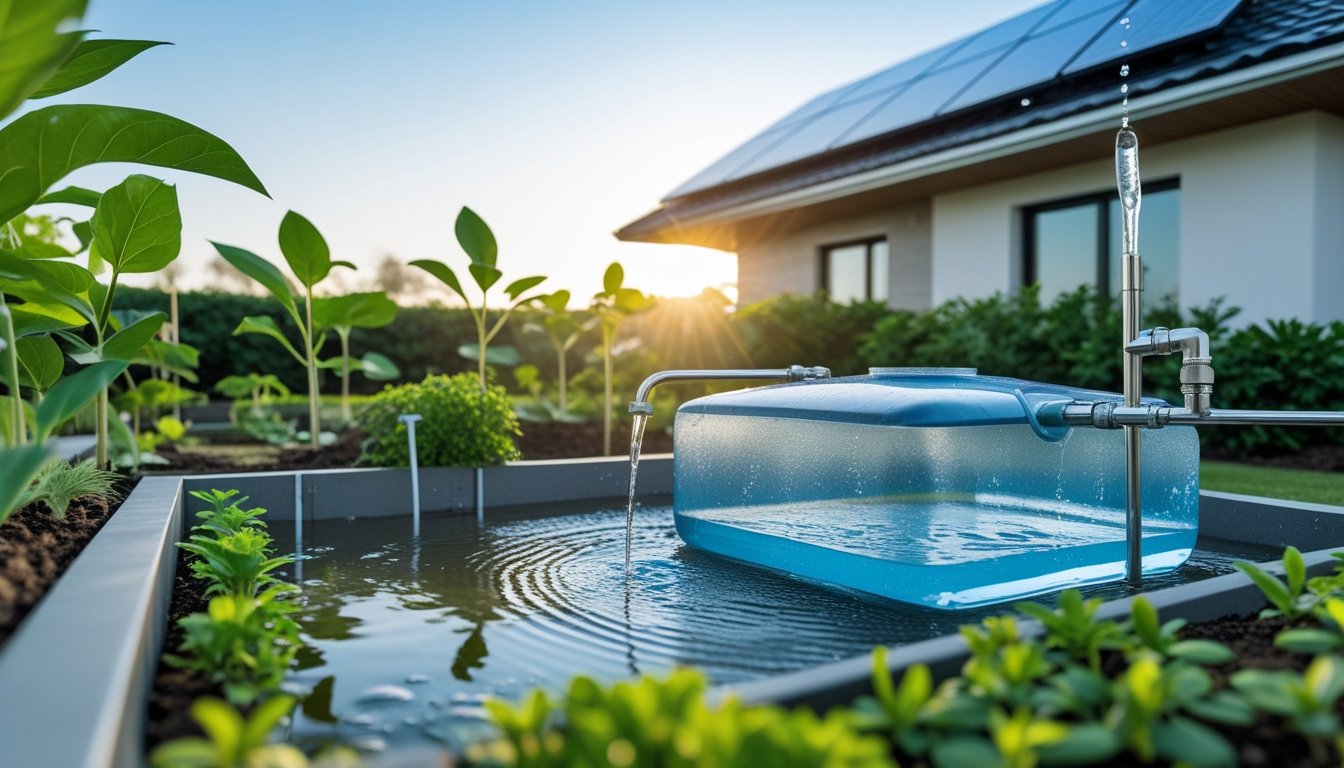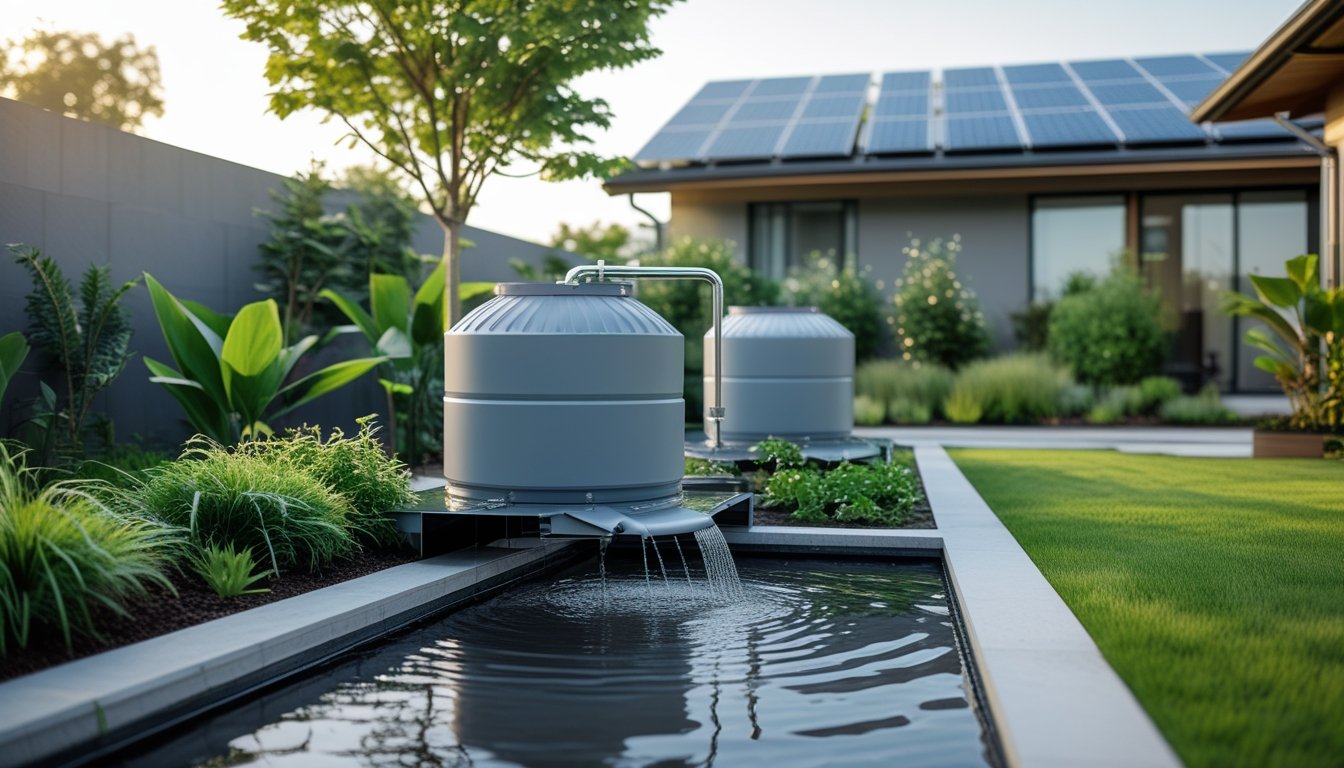Late updated: 27 Jul 2025 12:07
Written by: Eleanor Hartman
Innovative Eco-Friendly Home Water Collection Systems: Transforming Sustainable Living
In our rapidly evolving world, the quest for sustainability is at the forefront of innovative home design. We stand at a significant juncture where adopting eco-friendly water collection systems is not just a choice but a necessity. These systems offer a sustainable approach to water management, drastically reducing our reliance on traditional municipal supplies while offering significant economic advantages through lower utility bills.

At the core of these systems are advanced techniques like rainwater harvesting and greywater recycling, which enable us to reuse water efficiently and responsibly. As these practices gain traction, more homeowners are discovering that embracing such innovations can transform their homes into self-sustaining ecosystems. By integrating technology with sustainability, we've demonstrated that addressing water scarcity can indeed be stylish and functional.
These eco-friendly solutions not only conserve water but also contribute to preserving the planet for future generations. We explore the practical aspects of implementing these systems, showcasing their adaptability to various home settings and budgets. Our aim is to empower readers with the knowledge needed to make informed decisions, further igniting their passion for a sustainable future.
Key Takeaways
- Innovative systems reduce reliance on municipal water.
- Homeowners benefit from lower utility costs.
- Techniques support water reuse and conservation.
Core Elements of Innovative Eco-Friendly Home Water Collection Systems

When considering eco-friendly home water systems, several core components are essential: rainwater harvesting, vital infrastructure like gutters and tanks, advanced collection systems, and benefits of water storage. These elements work together to create sustainable living solutions.
How Rainwater Harvesting Works
Rainwater harvesting involves capturing and collecting rain from surfaces like rooftops. This method channels rainwater through a series of gutters into storage containers. The collected water then supports non-potable applications such as irrigation, toilet flushing, and laundry. By gathering rainwater, these systems reduce reliance on municipal water supplies. This not only lowers utility costs but also conserves a valuable resource. Furthermore, these systems can be tailored to meet the needs of individual homes, ensuring flexibility and efficiency.
Essential Components: Gutters, Water Tanks, and Cisterns
For effective rainwater harvesting, certain infrastructure is indispensable. Gutters efficiently direct rainwater from the roof into storage units. It's crucial to maintain them to prevent blockages. Water tanks and cisterns store the harvested rainwater. Tanks vary in size and can be installed above or below ground. Cisterns, often larger, can hold significant water volumes for extensive usage. Using durable, rust-resistant materials ensures longevity and purity of stored water. Innovative designs now incorporate filtration systems to remove impurities, enhancing water quality.
Modern Rainwater Collection Systems
The evolution of rainwater collection has introduced smart systems that integrate technology for optimal performance. These systems include automated controls to regulate water use and manage storage levels efficiently. Sensor technology helps monitor water quality and alerts users for maintenance needs. Stylish designs also offer aesthetic value, transforming functional systems into decorative features. Modern systems can adapt to various home setups, catering to limited urban spaces or large residential areas. This flexibility makes them accessible for many homeowners.
Water Storage and Conservation Benefits
By boosting water storage and conservation efforts, these systems significantly impact environmental sustainability. Stored rainwater offsets the demand on municipal resources, easing pressure on local water supplies. This method helps reduce water bills, particularly in regions with high utility costs. The conservation aspect also supports environmental health by reducing runoff and preventing soil erosion. Increased water availability during dry periods ensures gardens and lawns stay vibrant without depleting natural resources. Our innovative systems integrate these principles, paving the way for greener living.
Advanced Techniques and Sustainable Practices
Incorporating advanced water collection techniques in eco-friendly homes allows us to utilise natural resources more efficiently. By focusing on rain barrels, underground cisterns, and integrating rain gardens with natural filtration systems, as well as groundwater recharge and stormwater runoff control, we can contribute significantly to sustainable water management.
Rain Barrels and Underground Cisterns
Rain barrels and underground cisterns are fundamental to effective water collection. Rain barrels collect water directly from rooftop gutters, storing it for later use in gardening or cleaning. This not only reduces our reliance on municipal water supplies but also cuts down on water bills. Underground cisterns offer a larger storage capacity, making them suitable for household use beyond just irrigation.
The strategic placement of cisterns ensures minimal landscape disruption. They also maintain cooler temperatures, preventing algae growth. These systems are integral to sustainable home designs, providing long-term water security by capturing significant rainwater quantities. The implementation of such systems requires attention to detail, ensuring compatibility with existing structures.
Integration of Rain Gardens and Natural Filtration
Rain gardens combined with natural filtration techniques create a resilient system to manage rainwater. Rain gardens are shallow, planted depressions designed to absorb runoff from impervious surfaces like rooftops and driveways. They support local ecosystems by promoting biodiversity through native plant species.
Natural filtration occurs as water passes through soil layers and plant roots in these gardens. This process naturally removes pollutants, ensuring clean water eventually enters underground reservoirs. The well-planned integration of rain gardens can prevent flooding by slowing stormwater entry into sewer systems. Though simple in appearance, they require careful planning, especially concerning plant selection and garden depth.
Groundwater Recharge and Stormwater Runoff Control
Groundwater recharge plays a vital role in maintaining the balance of aquifers, which are essential for sustained water supply. By directing stormwater to recharge areas, we increase the infiltration rate, allowing more water to enter these underground reservoirs. This is beneficial in combating the rapid depletion of groundwater resources.
Control of stormwater runoff is equally pivotal. Methods such as permeable pavements, green roofs, and bioswales work collectively to capture and redirect water efficiently. They help in reducing surface runoff, which can otherwise lead to erosion and pollution. Implementing these methods in urban and suburban settings requires careful planning to maximise their effectiveness in encouraging sustainable water practices.
Frequently Asked Questions

Our exploration of home water collection systems offers insights into their advantages, safe usage, and practical applications. Learn about design considerations and the essential components of these systems.
What are the key benefits of installing a rainwater harvesting system at home?
Rainwater harvesting helps reduce water bills and promotes the conservation of natural resources. It provides an alternative water source during dry seasons, enhancing water security. Additionally, these systems can boost the property’s value by incorporating sustainable practices into home living.
How can one ensure the water collected through rainwater harvesting is safe for drinking?
To ensure safety, it is important to use a proper filtration and treatment system. Regularly maintaining and cleaning tanks, gutters, and pipes also helps. By integrating a reliable filtration process, such as UV treatment or activated carbon filters, we can improve water safety and quality for domestic use.
In which ways can harvested rainwater be used within domestic gardens?
Harvested rainwater is excellent for watering plants, maintaining lawns, and replenishing ponds. It supports a sustainable garden ecosystem by providing a chemical-free water source. Additionally, using this water conserves tap water resources and supports plant health by reducing the use of treated water, which may contain chlorine.
What are the essential components of a residential rainwater collection system?
Typical systems include a catchment area, such as a roof, gutters for directing the flow, a storage tank, and a filtration system. Each component plays a vital role in efficient water collection and safety. Proper integration and maintenance of these elements are key to effective rainwater harvesting.
What types of rainwater harvesting systems are available for home use?
There are several systems, ranging from simple barrel setups to more advanced rooftop collection systems. DIY kits are available, offering an affordable entry point. Larger systems can be installed for extensive water needs, tailored to fit specific household requirements and integrate with existing infrastructure.
How does one design a rainwater harvesting system to maximise efficiency?
Consider the roof size and local rainfall patterns for optimal catchment. Implementing a first-flush device can improve water quality by diverting initial runoff. Efficient storage and filtration designs must be considered to prevent overflow and ensure usability, while also incorporating automated systems where necessary for hands-off operation.